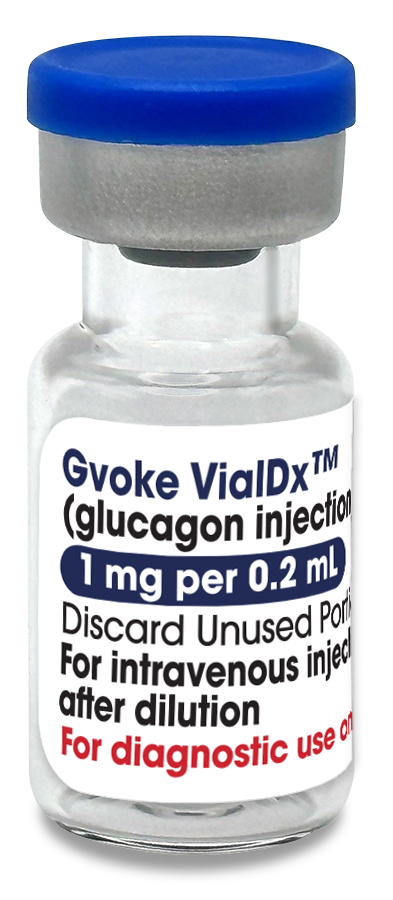Contact Us
By clicking Submit, you confirm that you accept our Privacy Policy and that you agree to your personal contact information being used to contact you and added to our database. If at any time you wish your personal information to be removed from the American Regent® database, please submit a message request to corpcommunications@americanregent.com.
CONTRAINDICATIONS
GVOKE VialDx is contraindicated in patients with:
- Pheochromocytoma, because of the risk of substantial increase in blood pressure
- Insulinoma, because of the risk of hypoglycemia
- Prior hypersensitivity reaction to glucagon or to any of the excipients in GVOKE VialDx. Serious hypersensitivity reactions have been reported with glucagon and include anaphylactic shock with breathing difficulties and hypotension
- Glucagonoma, because of risk of hypoglycemia
WARNINGS AND PRECAUTIONS
Substantial Increase in Blood Pressure in Patients With Pheochromocytoma
GVOKE VialDx is contraindicated in patients with pheochromocytoma because glucagon may stimulate the release of catecholamines from the tumor. If the patient develops a substantial increase in blood pressure and a previously undiagnosed pheochromocytoma is suspected, 5 to 10 mg of phentolamine mesylate, administered intravenously, has been shown to be effective in lowering blood pressure.
Hypoglycemia in Patients With Insulinoma
In patients with insulinoma, administration of glucagon may produce an initial increase in blood glucose; however, glucagon administration may directly or indirectly (through an initial rise in blood glucose) stimulate exaggerated insulin release from an insulinoma and cause hypoglycemia. GVOKE VialDx is contraindicated in patients with insulinoma. If a patient develops symptoms of hypoglycemia after a dose of GVOKE VialDx, give glucose orally or intravenously.
Serious Hypersensitivity Reactions
Serious hypersensitivity reactions have been reported with glucagon products, including generalized rash, and in some cases anaphylactic shock with breathing difficulties and hypotension. Discontinue GVOKE VialDx if symptoms of serious hypersensitivity reactions occur. Advise patients and/or caregivers to seek immediate medical attention if the patient experiences any symptoms of serious hypersensitivity reactions. GVOKE VialDx is contraindicated in patients with a prior hypersensitivity reaction to glucagon, or any of the excipients in GVOKE VialDx.
Necrolytic Migratory Erythema (NME)
NME, a skin rash commonly associated with glucagonomas (glucagon-producing tumors) and characterized by scaly, pruritic erythematous plaques, bullae, and erosions, has been reported postmarketing following continuous glucagon infusion. GVOKE VialDx is not approved for continuous infusion. NME lesions may affect the face, groin, perineum, and legs, or be more widespread. In the reported cases, NME resolved with discontinuation of the glucagon, and treatment with corticosteroids was not effective. Should NME occur, consider whether the benefits of continuous glucagon infusion outweigh the risks.
Hyperglycemia With Intravenous Use as a Diagnostic Aid in Patients With Diabetes Mellitus
GVOKE VialDx in patients with diabetes mellitus may cause hyperglycemia. Monitor patients with diabetes for changes in blood glucose levels during treatment with GVOKE VialDx and treat hyperglycemia, if indicated.
Blood Pressure and Heart Rate Increase in Patients With Cardiac Disease When Used as a Diagnostic Aid
GVOKE VialDx may increase myocardial oxygen demand, blood pressure, and pulse rate, which may be life-threatening in patients with cardiac disease. Cardiac monitoring is recommended in patients with cardiac disease during use of GVOKE VialDx as a diagnostic aid, and an increase in blood pressure and pulse rate may require therapy.
Hypoglycemia in Patients With Glucagonoma
GVOKE VialDx administered to patients with glucagonoma may cause secondary hypoglycemia. GVOKE VialDx is contraindicated in patients with glucagonoma when used as a diagnostic aid. Test patients suspected of having glucagonoma for blood levels of glucagon prior to treatment, and monitor for changes in blood glucose levels during treatment. If a patient develops symptoms of hypoglycemia after a dose of GVOKE VialDx, give glucose orally or intravenously.
ADVERSE REACTIONS
Clinical Trials Experience
The most common adverse reactions occurring in ≥5% of adult healthy volunteers who received 0.75 mg GVOKE VialDx intravenously were nausea, dysgeusia, headache, hot flush, and dizziness.
Postmarketing Experience
The following reactions have been identified during post-approval use of glucagon. Because these reactions are reported voluntarily from a population of uncertain size, it is generally not possible to reliably estimate their frequency or establish a causal relationship to drug exposure.
- Necrolytic migratory erythema (NME) cases have been reported postmarketing in patients receiving continuous infusion of glucagon
- Hypoglycemia and hypoglycemic coma. Patients taking indomethacin may be more likely to experience hypoglycemia following glucagon administration
DRUG INTERACTIONS
Patients taking beta-blockers may have a transient increase in pulse and blood pressure when given GVOKE VialDx.
Insulin acts antagonistically to glucagon.
The concomitant use of anticholinergic drugs and GVOKE VialDx increases the risk of gastrointestinal adverse reactions due to additive effects on inhibition of gastrointestinal motility.
GVOKE VialDx may increase the anticoagulant effect of warfarin.
USE IN SPECIFIC POPULATIONS
Pediatric Use
Safety and effectiveness of GVOKE VialDx for use as a diagnostic aid during radiologic examinations to temporarily inhibit movement of the gastrointestinal tract in pediatric patients have not been established.
Geriatric Use
Clinical studies of GVOKE VialDx did not include sufficient numbers of patients aged 65 and over to determine whether they respond differently from younger adult patients.
OVERDOSAGE
If overdosage occurs, the patient may experience nausea, vomiting, inhibition of GI tract motility, increase in blood pressure, and pulse rate. In case of suspected overdosing, serum potassium may decrease and should be monitored and corrected if needed. If the patient develops a dramatic increase in blood pressure, phentolamine mesylate has been shown to be effective in lowering blood pressure for the short time that control would be needed.
INDICATIONS AND USAGE
GVOKE VialDx is indicated for intravenous use as a diagnostic aid during radiologic examinations to temporarily inhibit movement of the gastrointestinal tract in adult patients.
Please see Full Prescribing Information.
You are encouraged to report Adverse Drug Events to Xeris Pharmaceuticals, Inc. at 1-877-937-4737, or to the FDA by visiting www.fda.gov/medwatch, or by calling 1-800-FDA-1088.
REF-2775 3/2025

